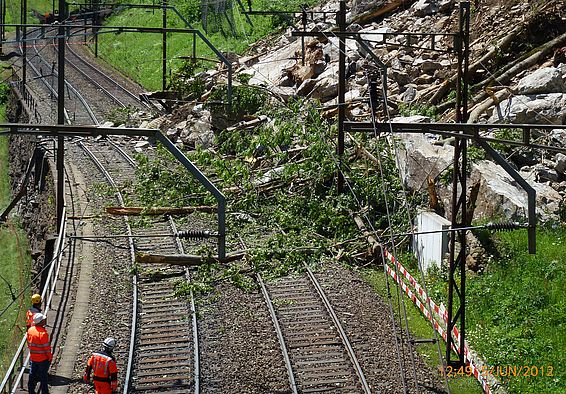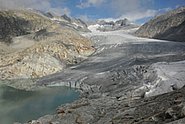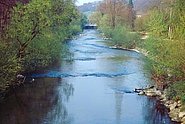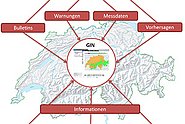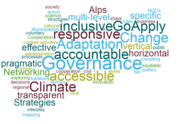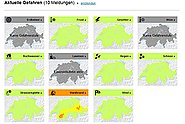In Switzerland, the potential for damage from natural hazards is increasing substantially. The main reason is the infrastructural and socio-demographic development combined with the global climate change. We research political and social processes in dealing with natural hazards so that the population can be protected as effectively and economically as possible.
Contents ¶
Since centuries, the Swiss population has learnt to live with devastations caused by natural hazards. Higher population density, investments in buildings and the expansion of traffic infrastructure boost the damage potential of such hazards. In the period between 1972 and 2020, the yearly average damage cost amounted to some 300 million francs.
Policy-makers and administrators are faced with the challenge of reducing risks by means of spatial planning, population protection and protective forests - at acceptable costs. This raises the question of how the population thinks about the respective measures, what costs they cause and how risk communication can be achieved in a way that is effective for successful risk prevention, emergency intervention and recovery. We investigate such questions in our economic and social science research. We make the results available e.g. to those responsible for security in a wide range of formats.
Our research concerned, among others, with the following topics:
- Prevention and risk reduction in diverse policy fields (spatial planning, civil protection and forestry)
- Individual and societal perception and understanding of natural hazard risks
- Participation in societal decision processes for coping with natural hazards
- Capacity building and resilience towards natural hazards
- Evaluation of the effectiveness of risk communication
- Economic aspects of natural hazards, e.g. for forest management, agriculture and tourism
- Users’ dealing with forecast and warning tools
Related Topics ¶
Contact ¶
Publications ¶
Maidl E., Bresch D.N., Buchecker M. (2021) Social integration matters: factors influencing natural hazard risk preparedness—a survey of Swiss households. Nat. Hazards. 105, 1861-1890. https://doi.org/10.1007/s11069-020-04381-2 Institutional Repository DORA
Unterberger C., Olschewski R. (2021) Determining the insurance value of ecosystems: a discrete choice study on natural hazard protection by forests. Ecol. Econ. 180, 106866 (16 pp.). https://doi.org/10.1016/j.ecolecon.2020.106866Institutional Repository DORA
Maidl E., Buchecker M. (2021) Local hazard consultants in Switzerland - an innovative social learning element in a community of practice. Int. J. Disaster Risk Reduct. 65, 102542 (13 pp.). https://doi.org/10.1016/j.ijdrr.2021.102542Institutional Repository DORA
Unterberger C., Olschewski R. (2020) Stated preference data on the insurance value of forests in Switzerland. Data Brief. 33, 106466 (6 pp.). https://doi.org/10.1016/j.dib.2020.106466Institutional Repository DORA
Kruse S., Abeling T., Deeming H., Fordham M., Forrester J., Jülich S., … Sharpe J. (2019) The emBrace resilience framework. Developing an integrated framework for evaluating community resilience to natural hazards. In H. Deeming, M. Fordham, C. Kuhlicke, L. Pedoth, S. Schneiderbauer, & C. Shreve (Eds.), Framing community disaster resilience: resources, capacities, learning, and action. Hoboken, NJ: Wiley. 79-96. https://doi.org/10.1002/9781119166047.ch6 Institutional Repository DORA
Jülich S. (2017) Towards a local-level resilience composite index: introducing different degrees of indicator quantification. Int. J. Disaster Risk Sci. 8(1), 91-99. https://doi.org/10.1007/s13753-017-0114-0 Institutional Repository DORA
Kruse S., Abeling T., Deeming H., Fordham M., Forrester J., Juelich S., … Schneiderbauer S. (2017) Conceptualizing community resilience to natural hazards - the emBRACE framework. Nat. Hazards Earth Syst. Sci. 17(12), 2321-2333. https://doi.org/10.5194/nhess-17-2321-2017 Institutional Repository DORA
Fekete A., Hufschmidt G., Kruse S. (2014) Benefits and challenges of resilience and vulnerability for disaster risk management. Int. J. Disaster Risk Sci. 5(1), 3-20. https://doi.org/10.1007/s13753-014-0008-3 Institutional Repository DORA
Buchecker M., Ogasa D., Maidl E. (2016) How well do the wider public accept integrated flood risk management? An empirical study in two Swiss Alpine valleys. Environ. Sci. Policy. 55, 309-317. https://doi.org/10.1016/j.envsci.2015.07.021 Institutional Repository DORA
Olschewski R. (2013) How to value protection from natural hazards – a step-by-step discrete choice approach. Nat. Hazards Earth Syst. Sci. 13(4), 913-922. https://doi.org/10.5194/nhess-13-913-2013 Institutional Repository DORA
Höppner C., Whittle R., Bründl M., Buchecker M. (2012) Linking social capacities and risk communication in Europe: a gap between theory and practice? Nat. Hazards. 64(2), 1753-1778. https://doi.org/10.1007/s11069-012-0356-5 Institutional Repository DORA
Olschewski R., Bebi P., Teich M., Wissen Hayek U., Grêt-Regamey A. (2012) Avalanche protection by forests - a choice experiment in the Swiss Alps. For. Policy Econ. 15, 108-113. https://doi.org/10.1016/j.forpol.2011.10.002 Institutional Repository DORA
Projects ¶
Services and products ¶
Links ¶
- Drought-CH: Information platform for early detection of drought in Switzerland

